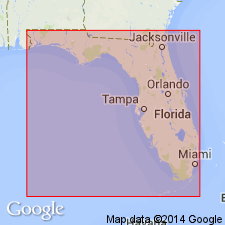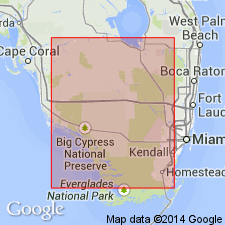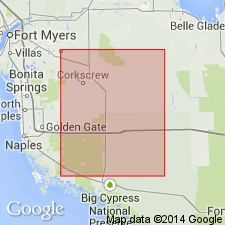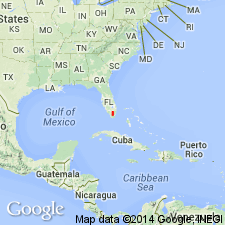
- Usage in publication:
-
- Punta Gorda anhydrite
- Modifications:
-
- First used
- Dominant lithology:
-
- Anhydrite
- AAPG geologic province:
-
- Florida platform
Summary:
Name credited to P.L. Applin and E.R. Applin (in press). Applied to distinctive beds of Trinity (Early Cretaceous) age. Occurs in FL subsurface.
Source: GNU records (USGS DDS-6; Reston GNULEX).

- Usage in publication:
-
- Punta Gorda Anhydrite*
- Modifications:
-
- Named
- Dominant lithology:
-
- Anhydrite
- Limestone
- Dolomite
- Shale
- AAPG geologic province:
-
- Florida platform
Summary:
Name formally proposed for lithologic unit that has been penetrated in beds of Trinity age. Composed chiefly of anhydrite and contains lesser amounts of irregularly interbedded limestone, dolomite, and dark shale. Occurs at depths of 11,690 to 12,157 ft in type well, here designated in Charlotte Co., FL. Underlies Sunniland limestone. Name selected by Louise Jordan. Age is Early Cretaceous.
Source: GNU records (USGS DDS-6; Reston GNULEX).

- Usage in publication:
-
- Punta Gorda Anhydrite
- Modifications:
-
- Revised
- AAPG geologic province:
-
- Florida platform
Summary:
Punta Gorda Anhydrite assigned to Glades Group (new) in subsurface of southern FL. Age is Early Cretaceous (early Trinity).
Source: GNU records (USGS DDS-6; Reston GNULEX).

- Usage in publication:
-
- Punta Gorda Formation
- Modifications:
-
- Overview
- Revised
- AAPG geologic province:
-
- Florida platform
Summary:
First called Anhydrite by Applin and Applin (1965), but here referred to as Formation for unit consists not only of anhydrite, but also of dolomite, limestone, and shale. Thickness is 144 m in study area. Overlies Fort Pierce Formation of Glades Group (Late Jurassic and Early Cretaceous). Underlies Sunniland Limestone of Ocean Reef Group (Early Cretaceous).
Source: GNU records (USGS DDS-6; Reston GNULEX).

- Usage in publication:
-
- Punta Gorda Anhydrite*
- Modifications:
-
- Overview
- AAPG geologic province:
-
- Florida platform
Summary:
Punta Gorda Anhydrite of Early Cretaceous (Comanchean) age is upper formation of Glades Group. Overlies Able Member of Lehigh Acres Formation (both new) of Glades Group; underlies Sunniland Limestone. Correlated with Ferry Lake Anhydrite.
Source: Modified from GNU records (USGS DDS-6; Reston GNULEX).

- Usage in publication:
-
- Punta Gorda Anhydrite
- Modifications:
-
- Overview
- AAPG geologic province:
-
- Florida platform
Summary:
Comanchean Punta Gorda Anhydrite of Glades Group correlates with Glen Rose and Stuart City Formations of TX. Overlies Early Cretaceous Lehigh Acres Formation. Underlies Early Cretaceous Sunniland Limestone of Ocean Reef Group.
Source: GNU records (USGS DDS-6; Reston GNULEX).
For more information, please contact Nancy Stamm, Geologic Names Committee Secretary.
Asterisk (*) indicates published by U.S. Geological Survey authors.
"No current usage" (†) implies that a name has been abandoned or has fallen into disuse. Former usage and, if known, replacement name given in parentheses ( ).
Slash (/) indicates name conflicts with nomenclatural guidelines (CSN, 1933; ACSN, 1961, 1970; NACSN, 1983, 2005, 2021). May be explained within brackets ([ ]).

